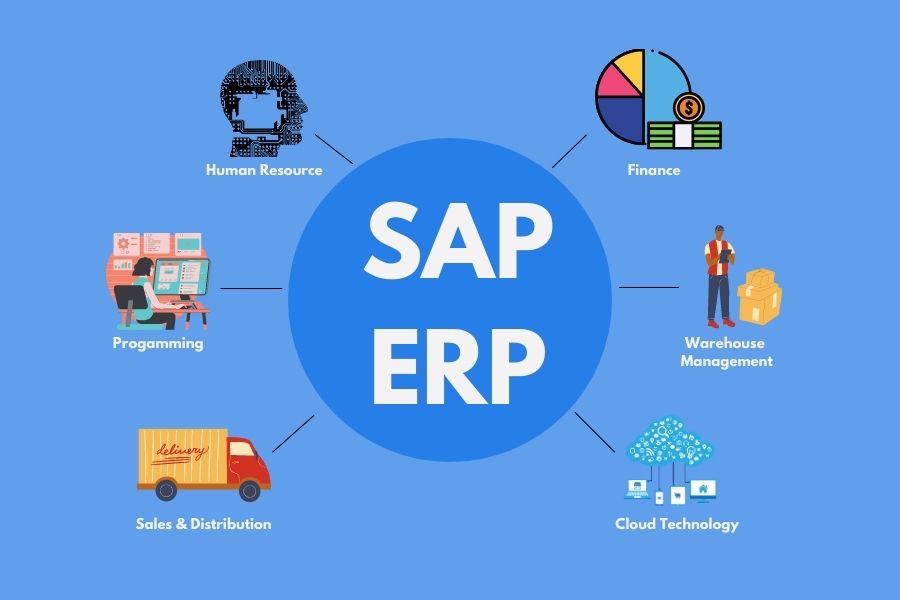Introduction

In today’s fast-paced business landscape, staying competitive requires not only innovative products and services but also streamlined operations. This is where SAP comes in—a powerful suite of business software solutions designed to optimize processes, enhance efficiency, and foster growth. In this comprehensive guide, we will delve into the world of SAP, exploring its features, benefits, and implementation. Whether you’re a business owner, executive, or enthusiast, read on to discover how SAP can transform your operations.
SAP stands for System Applications and Products in Data Processing

History of SAP
In 1972, five entrepreneurs had a vision for the business potential of technology.SAP established the global standard for enterprise resource planning (ERP) software.
- 1972: SAP is founded.
- 1973: The company releases SAP R/1, its first commercial product.
- 1979: SAP introduces SAP R/2, a mainframe-based business software suite.
- 1992: SAP R/3, a client-server architecture, is launched, marking a significant advancement.
- 1998: SAP AG becomes SAP SE.
- 2004: SAP NetWeaver is introduced, offering a comprehensive integration and application platform.
- 2010: SAP HANA, an in-memory database and platform, is unveiled, revolutionizing data processing and analytics.
- 2013: SAP Fiori, a new user experience for SAP applications, is introduced.
- 2015: SAP S/4HANA, the next-generation intelligent ERP suite, is launched.
Initially unveiled as SAP NetWeaver Cloud belonging to the SAP HANA Cloud portfolio on October 16, 2012 the cloud platform was reintroduced with the new name SAP HANA Cloud Platform on May 13, 2013 as the foundation for SAP cloud products, including the SAP BusinessObjects Cloud. Adoption of the SAP HANA Cloud Platform has increased steadily since the platform’s launch in 2012, with SAP claiming over 4000 customers and 500 partners adopting the SAP HANA Cloud Platform.
On February 27, 2017, SAP HANA Cloud Platform was renamed SAP Cloud Platform at the Mobile World Congress.
On January 18, 2021, SAP Cloud Platform was officially removed from SAP’s product portfolio to support SAP Business Technology Platform (SAP BTP).
SAP: Revolutionizing Business Operations
SAP, which stands for Systems, Applications, and Products in Data Processing, is a market-leading enterprise resource planning (ERP) software that empowers businesses to manage various functions seamlessly. From finance and HR to supply chain and customer relationship management (CRM), SAP provides an integrated platform that centralizes data and processes. With its user-friendly interface, SAP offers a holistic view of an organization’s operations, enabling data-driven decision-making.
Key Benefits of SAP Implementation
SAP implementation can yield a plethora of benefits that significantly impact business efficiency, growth, and profitability. Let’s explore some of the key advantages:
Enhanced Process Efficiency
SAP streamlines business processes by automating routine tasks, eliminating redundant steps, and reducing manual errors. This efficiency boost results in faster workflows, reduced operational costs, and improved resource allocation.
Data Visibility and Real-time Insights
With SAP’s integrated platform, data from various departments is consolidated, providing real-time insights into business performance. This visibility enables proactive decision-making and the identification of areas for improvement.
Improved Customer Experience
SAP’s CRM module allows businesses to manage customer interactions, track sales leads, and personalize experiences. This leads to enhanced customer satisfaction, loyalty, and retention.
Better Supply Chain Management
SAP’s supply chain module optimizes inventory management, demand forecasting, and supplier collaboration. Businesses can minimize stockouts, reduce excess inventory, and ensure timely deliveries.
Regulatory Compliance
SAP helps businesses adhere to industry regulations and compliance standards by automating data tracking and reporting. This ensures transparency and minimizes the risk of legal and financial penalties.
Scalability for Growth
As businesses expand, SAP scales seamlessly to accommodate increased data and user requirements. This scalability supports sustained growth without compromising performance.
SAP in Action: Real-world Success Stories
The impact of SAP can be witnessed across industries and business sizes. Here are a few real-world success stories that highlight how SAP has transformed operations:
Case Study 1: Manufacturing Marvel
A global manufacturing company struggled with supply chain complexities, leading to production delays and increased costs. With SAP implementation, they achieved end-to-end visibility, reduced lead times, and achieved a 20% increase in overall productivity.
Case Study 2: Retail Reinvented
A retail chain faced challenges in managing inventory and meeting customer demands. SAP’s integrated solution enabled them to optimize inventory levels, personalize marketing efforts, and increase customer retention by 15%.
Case Study 3: Financial Flourish
A financial institution grappled with manual data entry and compliance issues. SAP’s automation streamlined data management, reduced errors, and accelerated reporting processes, resulting in a 30% reduction in compliance-related costs.
Exploring SAP’s Robust Features
SAP’s comprehensive suite of solutions encompasses various modules that cater to different aspects of business operations. Let’s explore some of the core features of SAP:
1. Finance and Accounting
SAP’s finance module automates financial processes such as accounts payable, receivable, and general ledger management. It enables accurate financial reporting and compliance tracking.
2. Human Resources Management
The HR module manages employee data, payroll, benefits administration, and performance evaluations. It enhances HR efficiency and promotes employee engagement.
3. Supply Chain Management
SAP’s supply chain module optimizes inventory management, demand forecasting, and order fulfillment. It ensures efficient supply chain operations and minimizes disruptions.
4. Customer Relationship Management
SAP’s CRM module centralizes customer data, sales leads, and marketing campaigns. It enhances customer experiences and enables targeted marketing efforts.
5. Business Intelligence and Analytics
SAP’s analytics tools provide insights into business performance, trends, and forecasts. It empowers data-driven decision-making and strategic planning.
6. Enterprise Mobility
SAP’s mobile solutions enable employees to access data and perform tasks remotely. It enhances productivity and responsiveness in a mobile-centric world.
Conclusion: Embrace Efficiency and Growth with SAP
In the ever-evolving business landscape, embracing innovation is key to success. SAP stands as a powerful ally in this journey, offering solutions that drive efficiency, enhance decision-making, and foster growth. With its diverse modules, SAP caters to various aspects of business operations, ensuring a comprehensive and integrated approach. Whether you’re a large enterprise or a growing startup, SAP has the potential to revolutionize your operations and pave the way for a prosperous future.

